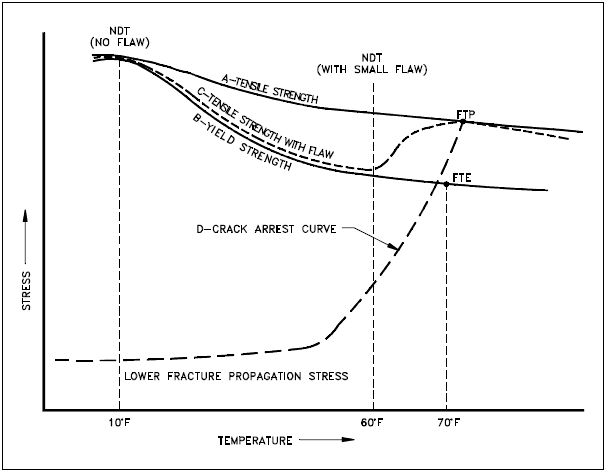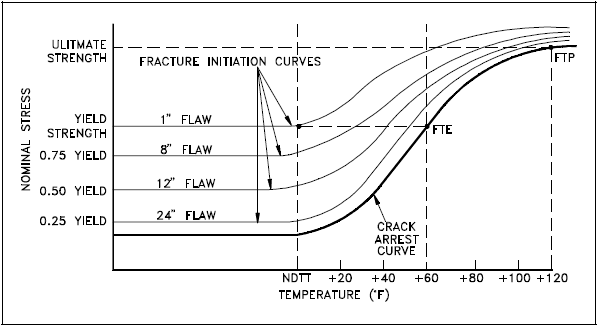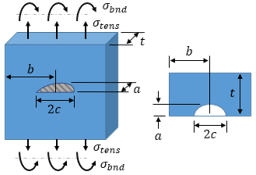Brittle Fracture
This page provides the chapters on brittle fracture from the "DOE Fundamentals Handbook: Material Science," DOE-HDBK-1017/1-93, U.S. Department of Energy, Jan 1993.
Other related chapters from the "DOE Fundamentals Handbook: Material Science" can be seen to the right.
- Structure of Metals
- Properties of Metals
- Material Selection
- Thermal Stress
- Brittle Fracture
Brittle Fracture Mechanism
Personnel need to understand brittle fracture. This type of fracture occurs under specific conditions without warning and can cause major damage to plant materials.
Brittle Fracture Mechanism
Metals can fail by ductile or brittle fracture. Metals that can sustain substantial plastic strain or deformation before fracturing exhibit ductile fracture. Usually a large part of the plastic flow is concentrated near the fracture faces.
Metals that fracture with a relatively small or negligible amount of plastic strain exhibit brittle fracture. Cracks propagate rapidly. Brittle failure results from cleavage (splitting along definite planes). Ductile fracture is better than brittle fracture, because ductile fracture occurs over a period of time, whereas brittle fracture is fast, and can occur (with flaws) at lower stress levels than a ductile fracture. Figure 1 shows the basic types of fracture.
Brittle cleavage fracture is of the most concern in this module. Brittle cleavage fracture occurs in materials with a high strain-hardening rate and relatively low cleavage strength or great sensitivity to multi-axial stress.

Many metals that are ductile under some conditions become brittle if the conditions are altered. The effect of temperature on the nature of the fracture is of considerable importance. Many steels exhibit ductile fracture at elevated temperatures and brittle fracture at low temperatures. The temperature above which a material is ductile and below which it is brittle is known as the Nil-Ductility Transition (NDT) temperature. This temperature is not precise, but varies according to prior mechanical and heat treatment and the nature and amounts of impurity elements. It is determined by some form of drop-weight test (for example, the Izod or Charpy tests).
Ductility is an essential requirement for steels used in the construction of reactor vessels; therefore, the NDT temperature is of significance in the operation of these vessels. Small grain size tends to increase ductility and results in a decrease in NDT temperature. Grain size is controlled by heat treatment in the specifications and manufacturing of reactor vessels. The NDT temperature can also be lowered by small additions of selected alloying elements such as nickel and manganese to low-carbon steels.
Of particular importance is the shifting of the NDT temperature to the right (Figure 2), when the reactor vessel is exposed to fast neutrons. The reactor vessel is continuously exposed to fast neutrons that escape from the core. Consequently, during operation the reactor vessel is subjected to an increasing fluence (flux) of fast neutrons, and as a result the NDT temperature increases steadily. It is not likely that the NDT temperature will approach the normal operating temperature of the steel. However, there is a possibility that when the reactor is being shut down or during an abnormal cooldown, the temperature may fall below the NDT value while the internal pressure is still high. The reactor vessel is susceptible to brittle fracture at this point. Therefore, special attention must be given to the effect of neutron irradiation on the NDT temperature of the steels used in fabricating reactor pressure vessels. The Nuclear Regulatory Commission requires that a reactor vessel material surveillance program be conducted in water-cooled power reactors in accordance with ASTM Standards (designation E 185-73).
Pressure vessels are also subject to cyclic stress. Cyclic stress arises from pressure and/or temperature cycles on the metal. Cyclic stress can lead to fatigue failure. Fatigue failure, discussed in more detail in Module 5, can be initiated by microscopic cracks and notches and even by grinding and machining marks on the surface. The same (or similar) defects also favor brittle fracture.
Looking for Fracture Calculators?
Here are a few to choose from:
Stress-Temperature Curves
One of the biggest concerns with brittle fracture is that it can occur at stresses well below the yield strength (stress corresponding to the transition from elastic to plastic behavior) of the material, provided certain conditions are present. These conditions are: a flaw such as a crack; a stress of sufficient intensity to develop a small deformation at the crack tip; and a temperature low enough to promote brittle fracture. The relationship between these conditions is best described using a generalized stress-temperature diagram for crack initiation and arrest as shown in Figure 2.

Figure 2 illustrates that as the temperature goes down, the tensile strength (Curve A) and the yield strength (Curve B) increase. The increase in tensile strength, sometimes known as the ultimate strength (a maximum of increasing strain on the stress-strain curve), is less than the increase in the yield point. At some low temperature, on the order of 10°F for carbon steel, the yield strength and tensile strength coincide. At this temperature and below, there is no yielding when a failure occurs. Hence, the failure is brittle. The temperature at which the yield and tensile strength coincide is the NDT temperature.
When a small flaw is present, the tensile strength follows the dashed Curve C. At elevated temperatures, Curves A and C are identical. At lower temperatures, approximately 50°F above the NDT temperature for material with no flaws, the tensile strength curve drops to the yield curve and then follows the yield curve to lower temperatures. At the point where Curves C and B meet, there is a new NDT temperature. Therefore, if a flaw exists, any failure at a temperature equal or below the NDT temperature for flawed material will be brittle.
Crack Initiation and Propagation
As discussed earlier in this chapter, brittle failure generally occurs because a flaw or crack propagates throughout the material. The start of a fracture at low stresses is determined by the cracking tendencies at the tip of the crack. If a plastic flaw exists at the tip, the structure is not endangered because the metal mass surrounding the crack will support the stress. When brittle fracture occurs (under the conditions for brittle fracture stated above), the crack will initiate and propagate through the material at great speeds (speed of sound). It should be noted that smaller grain size, higher temperature, and lower stress tend to mitigate crack initiation. Larger grain size, lower temperatures, and higher stress tend to favor crack propagation. There is a stress level below which a crack will not propagate at any temperature. This is called the lower fracture propagation stress. As the temperature increases, a higher stress is required for a crack to propagate. The relationship between the temperature and the stress required for a crack to propagate is called the crack arrest curve, which is shown on Figure 2 as Curve D. At temperatures above that indicated on this curve, crack propagation will not occur.
Looking for Fracture Calculators?
Here are a few to choose from:
Fracture Toughness
Fracture toughness is an indication of the amount of stress required to propagate a preexisting flaw. The fracture toughness of a metal depends on the following factors.
- Metal composition
- Metal temperature
- Extent of deformations to the crystal structure
- Metal grain size
- Metal crystalline form
The intersection of the crack arrest curve with the yield curve (Curve B) is called the fracture transition elastic (FTE) point. The temperature corresponding to this point is normally about 60°F above the NDT temperature. This temperature is also known as the Reference Temperature - Nil-ductility Transition (RTNDT) and is determined in accordance with ASME Section III (1974 edition), NB 2300. The FTE is the temperature above which plastic deformation accompanies all fractures or the highest temperature at which fracture propagation can occur under purely elastic loads. The intersection of the crack arrest curve (Curve D) and the tensile strength or ultimate strength, curve (Curve A) is called the fracture transition plastic (FTP) point. The temperature corresponding with this point is normally about 120°F above the NDT temperature. Above this temperature, only ductile fractures occur.
Figure 3 is a graph of stress versus temperature, showing fracture initiation curves for various flaw sizes.

It is clear from the above discussion that we must operate above the NDT temperature to be certain that no brittle fracture can occur. For greater safety, it is desirable that operation be limited above the FTE temperature, or NDT + 60°F. Under such conditions, no brittle fracture can occur for purely elastic loads.
As previously discussed, irradiation of the pressure vessel can raise the NDT temperature over the lifetime of the reactor pressure vessel, restricting the operating temperatures and stress on the vessel. It should be clear that this increase in NDT can lead to significant operating restrictions, especially after 25 years to 30 years of operation where the NDT can raise 200°F to 300°F. Thus, if the FTE was 60°F at the beginning of vessel life and a change in the NDT of 300°F occurred over a period of time, the reactor coolant would have to be raised to more than 360°F before full system pressure could be applied.
PDH Classroom offers a continuing education course based on this brittle fracture reference page. This course can be used to fulfill PDH credit requirements for maintaining your PE license.
Now that you've read this reference page, earn credit for it!




